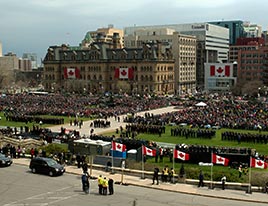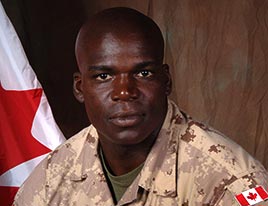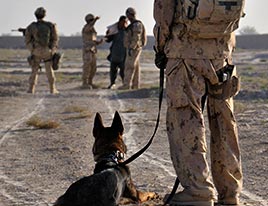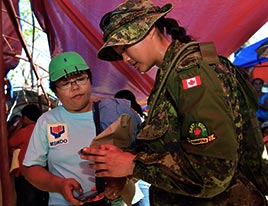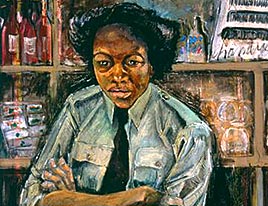Canada Remembers Times - 2014 Edition - Page 4
The Canadian Armed Forces Leave Afghanistan
A view of Parliament Hill in Ottawa during the National Day of Honour Ceremony on May 9, 2014.
(Photo: PMO photo by Jason Ransom)
Students in this year’s graduating classes were just in kindergarten when the first Canadian Armed Forces members arrived in Afghanistan more than 12 years ago.
The September 11, 2001, terrorist attacks in the United States set off a chain of events that would see Canada join a multinational campaign to oust the Taliban government from Afghanistan. These extremists had sheltered al-Qaeda, the terrorist group behind the deadly attacks in the United States. Our navy and air force patrolled the waters of the Arabian Sea looking for boats engaged in illegal activities. Our army hit the ground to help defeat the Taliban forces and try to stabilize the long-troubled country. Danger was never far away, but our soldiers would experience their most perilous duty in the enemy hotbed of Kandahar Province. Road-side explosions, ambushes and rocket attacks were a constant threat. In 2011, the Canadian efforts shifted to training the Afghan military and police forces to help them better secure their own country.
More than 40,000 Canadians served in this rugged Southwest Asian country. Sadly, 158 of them lost their lives there and hundreds more were wounded. Our military efforts in Afghanistan ended in March 2014, at which time our country’s flag was lowered there for the last time, was brought home and was then featured in a commemorative national parade.
Olympian Soldier
Private Mark Graham
(Photo: Department of National Defence)
With the 2014 Winter Olympic Games having taken place in Sochi this year, it seems fitting to remember Olympian soldier Mark Graham.
Born in Jamaica, Mark moved to Hamilton, Ontario, with his family when he was a child. An exceptional athlete, he was a member of the Canadian 4 x 400 metres relay team in the 1992 Summer Olympic Games in Barcelona, Spain. Graham’s skills in track-and-field would also earn him athletic scholarships at American universities.
In 2004, he enlisted in the Canadian Armed Forces. Private Graham was sent to Afghanistan with the Royal Canadian Regiment. Sadly, the 33-year-old was killed by friendly fire on September 6, 2006, when his platoon was mistakenly attacked by an American warplane during an operation to capture a Taliban stronghold west of Kandahar. Graham is buried at the National Military Cemetery in Ottawa.
Canine Comrades
Specially-trained dogs have long helped soldiers during times of war and may also offer comfort for some Veterans after their service.
(Photo: Department of National Defence IS2010-3031-20)
Gunfire, mayhem and death; Canadian Armed Forces members who saw action in places like Rwanda, Somalia, Bosnia and Afghanistan experienced things that often had a lasting effect on them. Those battlefields caused not only physical injuries, but also many invisible scars.
Operational stress injuries, like post-traumatic stress disorder (PTSD), can result from traumatic experiences. Symptoms vary from person to person, but can include things like depression, anxiety, flashbacks and nightmares.
Traditionally, those diagnosed with PTSD are treated with counseling and medication. However, is it possible that man’s best friend could also help? Some Veterans have had positive results by also using service dogs. These special dogs are trained to perform tasks for their handlers, such as reminding them to take their medication, guiding them away from stressful situations, or helping to support them if they become dizzy.
While dogs once helped deliver medicine to soldiers on the battlefields in the First World War, they are still looking after soldiers’ health today in a very comforting way.
Operation Renaissance in the Philippines
Canadian DART Liaison Officer in Philippines, 2013.
(Photo: Department of National Defence IS2013-2006-103)
The Southeast Asian country of the Philippines was hit hard by Typhoon Haiyan on November 8, 2013. Canadians responded immediately, donating supplies and money to help international organizations assist the local population in need.
The Canadian Armed Forces were quick to deploy personnel to the troubled area, sending the Disaster Assistance Response Team (DART). The first DART members arrived on November 15 to provide much needed humanitarian assistance. During Operation Renaissance, DART members helped clear roads, re-established communications, repaired power lines, purified water and treated the injured. More than 300 Canadians took part in the operation, which came to an end on December 15, 2013.
Women’s Brush with War
‘Private Roy, Canadian Women’s Army Corps’ by war artist Molly Lamb Bobak.
(Photo: Canadian War Museum 19710261-1626)
In a time before modern technology transformed the way we share information, war art was an important way of capturing Canada’s efforts in the two world wars. Hundreds of thousands of women had to assume many new responsibilities and perform tasks traditionally dominated by men. Some women artists were soon asked to portray this “women’s work.”
For example, during the First World War, Mabel May used an impressionist technique to show women working in munitions factories. During the Second World War, Molly Lamb Bobak, Pegi Nicol MacLeod and Paraskeva Clark were some of Canada’s leading female war artists.
Their artwork helps us see the war years from a female perspective. Mothers of soldiers, factory girls, military nurses, and women serving in a variety of roles with the Canadian Women’s Army Corps, the Women’s Royal Canadian Naval Service, and the Royal Canadian Air Force - Women’s Division were immortalized for future generations. These artists’ creations help paint a fuller picture of our collective memory of war. Several women today are part of the Canadian Forces Artists Program. They have been deployed to places such as Kosovo and Afghanistan, ushering in a new era of Canadian military art.
Crossword Puzzle
Did you read the newspaper stories carefully? All the answers to the crossword clues are found in the newspaper.
Use the clues to fill in the correct answers, one letter per square, both across and down.

Across
- 3. Area in Afghanistan where Canadians saw dangerous duties (8 letters).
- 4. City where Milton Gregg enlisted during the First World War (7 letters).
- 5. Hometown of Roger Coulombe, “the Berlin Kid” (9 letters).
- 7. Codename of beach where Canadians came ashore on D-Day (4 letters).
- 8. Italian town where Canadians fought during Christmas 1943 (6 letters).
- 9. Southeast Asian country where the DART team was deployed in 2013 (11 letters).
- 10. Place in Belgium where George Baker was killed in action (5 letters).
Down
- 1. Codename of the ongoing Canadian military operation in Cyprus (9 letters).
- 2. City in British Columbia where Private George McLean was born (8 letters).
- 6. Last name of Olympian soldier who was killed in Afghanistan (6 letters).
- Date modified:
